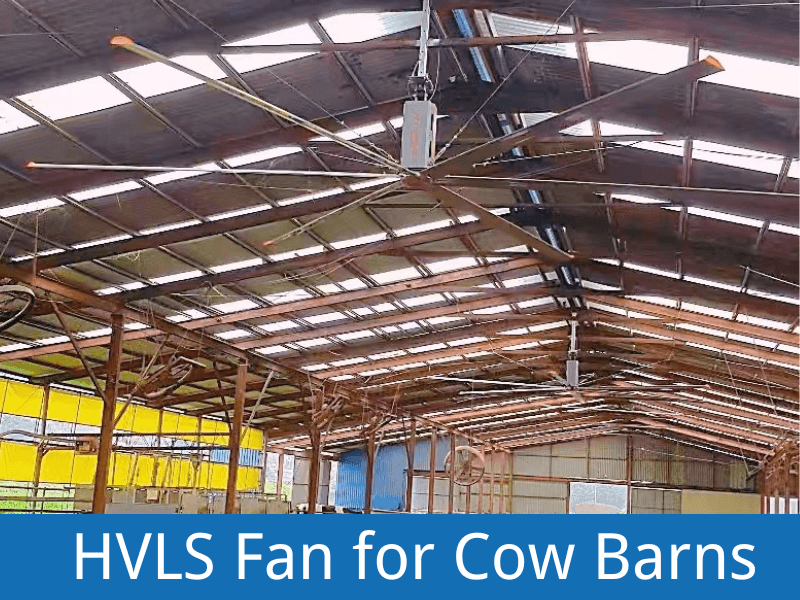The dairy farming sector is experiencing a paradigm shift, shifting away to the use of barns and stepping to automation and technology-driven precision livestock farming. With increasing global demand of milk estimated at 1 billion tons by 2030, farmers are under pressure to increase their efficiency, cut costs, and achieve more sustainability. Barn ventilation, which was once a manual affair, is now a smart problem requiring clever solutions that must guarantee animal welfare and profitability. Smart ceiling fans have begun to become part of this development, and come with IoT connectivity and sensors, providing smart dairy farm fans, IoT livestock ventilation, and automated cooling barns. These fans are transforming the future of dairy farming by maximizing airflow, decreasing energy consumption, and connecting with digital technology. RTFANS has more than 20 years of experience in ventilation solutions and is leading in this revolution. This article discusses the emergence of intelligent ceiling fans, its use, advantages, and why they hold the key to sustainable and efficient dairy farming.
The Rise of Smart Ceiling Fans
Precision Livestock Farming (PLF) is a technology employed by the dairy industry to track and streamline animal health and output. Smart ceiling fans (especially High-Volume Low-Speed (HVLS) fans) are a staple of this transition, incorporating the latest technologies to improve the management of the barn.
IoT Connectivity and Sensors
The Smart HVLS fans 8-24 feet in diameter have a real-time temperature, humidity, and air quality sensor powered by IoT. Such sensors transmit information to cloud applications, allowing automatic control of fan speed. An example of this is the use of a fan to blow more air during a heat spike or less air on cooler nights to maintain optimal conditions. Research indicates that IoT-driven ventilators can enhance the performance of farms by 15-20% with less oversight.

Integration with Smart Barn Systems
Smart fans connect to barn management systems (BMS) through Wi-Fi or Bluetooth and are connected to ammonia, CO2, and occupancy sensors. This permits dynamic control, with fans operating to achieve set conditions such as 50-68 F (10-20 C) and less than 60% humidity, according to ASABE ventilation standards. PLF study points out that combined systems reduce operational errors by ten percent.
Remote Monitoring and AI-Driven Control
Farmers have access to alerts on anomalies such as high humidity through mobile apps that allow them to monitor and control fans remotely. The AI programs forecast heat stress depending on weather conditions or animal behavior and regulate airflow in advance. This is how the IoT ceiling fans refine dairy farming approach in a way that saves time and resources.
Applications of Smart Fans in Dairy Farming
Smart HVLS fans have a wide range of uses which helps to solve major dairies problems.
Heat Stress Prevention with Automated Adjustments
At temperatures above 68 (20 C) the heat stress decreases milk production by 10-25%. Smart fans have sensors to notice rises and automatically respond by turning up the fan, to cool perceived temperatures by 5-10F using wind-chill. This eliminates wastage as experienced in farms where automated fans have increased production by 5-10%.
Animal Comfort for Cows and Calves
Regular ventilation means that the conditions remain consistent throughout the barns, and future ventilation technology in dairy farms will rely on it. In the case of calves, a draft-free environment with a low oxygen concentration prevents respiratory complications by 15-20%. Cows have the added comfort and are able to eat more feed 5-10%.

Disease Control Through Airflow Management
Smart fans eliminate 15-25 percent of ammonia and pathogens by pushing gases to exhausts. The sensors sense spikes, leading to increased airflow to prevent pneumonia, which occurs in one-fifth to a thirds of calves kept in poorly ventilated barns. This is consistent with the veterinary disease prevention guidelines.
Energy Optimization with Smart Scheduling
Occupancy or weather scheduling Fans reduce HVAC costs by 20-30 percent with less than 1.5 kW of operations. During the summer, they permit warmer thermostats (3-5, O savings of 4% per degree); in winter, they reuse warm air. This promotes computerized cooling barns on livestock that uses little energy.
Benefits for Farmers
Smart ceiling fans provide disruptive value to improve productivity and sustainability.
Improved Milk Yields Due to Reduced Stress
Reduced heat stress can boost milk production by 300-1,000 pounds per lactation, equating to an addition of 5,000-15,000 dollars per 100-cow herd per year. Intelligent fans guarantee a steady temperature, increasing output.
Cost Savings Through Energy Efficiency
Smart fans are inexpensive options with a 12-24-month payback period and energy savings of between 2,000 and $5,000 per year in a 20,000-square-foot barn. Minimal maintenance (200-500/year) will extend savings.
Data Collection for Better Farm Management
IoT sensors present information about air quality and temperature patterns, which can be used to predict maintenance and health issues. Farms that process PLF data indicate 10 percent improved decision-making.
Contribution to Sustainability Goals
Smart fans use less energy, cutting emissions by 20-30 percent, which meets the requirements of ISO 14001 and LEED. This helps corporate on the ESG aspects, improving reputation of the farm.
Future Outlook: Connected, Green, and Automated
The future of dairy farming is associated and sustainable, and smart fans are at the forefront.

Integration with Renewable Energy Systems
The low power consumption of HVLS fans means that they can be easily integrated into the sun with minimal reliance on fossil fuels. Smart fans on a solar-powered barn can reduce electricity bills by one-fourth, according to agricultural tech research.
AI Predicting Heat Stress
AI-based fans anticipate heat stress based on the weather and cow behavior data and adjust the airflow accordingly. This has the potential to save 15-20% in losses by 2030, as the use of PLF expands.
Role in Animal Welfare Certifications
By reducing air pollution and providing the most comfortable experience, Smart fans can help certifications such as Global Animal Partnership, which would attract eco-aware buyers and enhance marketability.
FAQ: Common Questions About Smart Fans in Dairy Farming
- What makes a ceiling fan “smart” in dairy farming?
With AI and IoT sensors, smart dairy farm fans can be optimized in terms of air quality and efficiency through real-time monitoring and automated adjustments. - Do smart fans work without the internet?
Yes, they work with pre-configured controls, however, the internet supplements IoT livestock ventilation with the remote monitoring and artificial intelligence capabilities. - How do IoT fans integrate with existing barn management systems?
They connect to Wi-Fi/Bluetooth with BMS, and they control airflow adjusting to sensor readings of connected barn cooling systems. - How do smart fans improve farm sustainability?
They meet green aspirations and digital farming ventilation by reducing energy consumption by 20-30 percent and emissions.
Conclusion
Dairy farming is welcoming digital transformation, and smart ceiling fans lead the pack, providing accuracy, efficiency and sustainability. Smart dairy farm fans improve both the welfare of the animals and reduce costs by connecting with the IoT and smart systems. Smart ceiling fans should be embraced by farmers as the new era of dairy farming to enhance productivity and achieve the objective of greening. The 20+ year-experienced RTFANS provides customized automated barn cooling systems. Get in touch to future-proof your farm, your herd and your profits.
